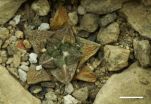(Press-News.org) Mildew infections not only cause unsightly vegetable patches, they can also result in extensive crop failure. Interestingly, the processes involved in infections with this garden pest are similar to those involved in fertilisation. Scientists from the Max Planck Institute for Plant Breeding Research in Cologne and the University of Zurich have identified two proteins in the model plant species Arabidopsis thaliana that are necessary for both fertilisation and infection with powdery mildew. This explains why mildew-resistant plants, in which these genes are mutated, are infertile. (Science, Vol 330, p 968-971)
Pollen tubes and hyphae, the filamentous structures of which fungi are formed, not only look very similar, they also require similar proteins. The two proteins in question, which have just been discovered, are named after the Etruscan fertility goddesses Feronia and Nortia. The scientists discovered that these proteins are both beneficial and harmful to plants. They link the capacity for seed formation with the absence of resistance to mildew infection.
Feronia signals to the pollen tube, which germinates from the pollen, that it has reached its destination and that it is time to release the male gametes. The protein is also formed in the leaves, however, and provides mildew with access to the plant. For the latter to become resistant to the intruder, both the maternal and paternal copies of the feronia gene must be defective. If the plant lacks the feronia protein, however, the pollen tube does not stop growing at the entrance to the embryo sac but continues to penetrate into the female part of the flower and does not trigger the release of sperm cells. As a result, fertilisation does not take place and an embryo does not develop.
The protein Nortia is also involved in fertilisation; however, it does not occur in the leaves. A protein known as MLO, which is closely related to Nortia, is found there instead. MLO makes plants, e.g. barley, in which Ralph Panstruga discovered the MLO gene a few years ago, prone to mildew. However, they only become resistant if both copies of the MLO gene are mutated. Because Arabidopsis has three MLO genes that play a role in susceptibility to mildew, in this plant, six copies must become defunct before it becomes resistant to mildew. Various other genes exist, however, that also cause resistance to fungal infections in plants.
Resistant or fertile
Feronia and Nortia are formed by the helper cells of the embryo sac. They bring about the fusion of the gametes in the ovary. Feronia and MLO in the leaves enable mildew to penetrate into the plant. "This dual function indicates why evolution has not yet succeeded in blocking this point of access to mildew. It would clearly be very difficult to decouple these two functions. Therefore, the alternatives are: resistant and infertile, or vulnerable and fertile," says Ralph Panstruga from the Max Planck Institute for Plant Breeding Research.
Feronia is a receptor that apparently directly influences Nortia. However, the scientists do not yet know how Feronia cooperates with Nortia and MLO. "Our goal is to breed mildew-resistant plants based on Feronia mutants that are also fertile," says Panstruga. This is a very ambitious aim, as evolution appears not to have produced any such mutants up to now. Feronia evidently plays such an important role in the ovary and the leaves that the plant simply cannot manage without it.
INFORMATION:
Original work:
Sharon A. Kessler, Hiroko Shimosato-Asano, Nana F. Keinath, Samuel E. Wuest, Gwyneth Ingram, Ralph Panstruga and Ueli Grossniklaus
Conserved Molecular Components for Pollen Tube Reception and Fungal Invasion
Science, 12 November 2010, 330: 968-971
Mildew-resistant and infertile
2010-11-25
ELSE PRESS RELEASES FROM THIS DATE:
IOF and ESCEO position on atypical femoral fractures and long-term bisphosphonate use
2010-11-25
Leading experts from the European Society on Clinical and Economic Aspects of Osteoporosis and Osteoarthritis (ESCEO) and the International Osteoporosis Foundation (IOF) have published a timely position paper on the association between subtrochanteric femoral (upper thigh bone) fractures and long-term treatment with bisphosphonates.
Bisphosphonates are the most common drug therapy for osteoporotic fracture prevention, prescribed to millions of people around the world. Concern among doctors and patients has arisen following recent media reports that cite a possible association ...
MIT biologists find that restoring the gene for cancer protein p53 slows spread of advanced tumors
2010-11-25
CAMBRIDGE, Mass. -- In a new study to be published in the Nov. 25 issue of Nature, MIT cancer biologists show that restoring the protein p53's function in mice with lung cancer has no effect early in tumor development, but restoring the function later on could prevent more advanced tumors from spreading throughout the body.
Cancer researchers have known since the 1980s that p53 plays a critical role in protecting cells from becoming cancerous. P53 is defective in about half of all human cancers; when it functions correctly, it appears to suppress tumor formation by preventing ...
New imaging technique accurately finds cancer cells, fast
2010-11-25
CHAMPAIGN, Ill. – The long, anxious wait for biopsy results could soon be over, thanks to a tissue-imaging technique developed at the University of Illinois.
The research team demonstrated the novel microscopy technique, called nonlinear interferometric vibrational imaging (NIVI), on rat breast-cancer cells and tissues. It produced easy-to-read, color-coded images of tissue, outlining clear tumor boundaries, with more than 99 percent confidence – in less than five minutes.
Led by professor and physician Stephen A. Boppart, who holds appointments in electrical and computer ...
Massive galaxies formed when universe was young
2010-11-25
MEDFORD/SOMERVILLE, Mass. -- Some of the universe's most massive galaxies may have formed billions of years earlier than current scientific models predict, according to surprising new research led by Tufts University. The findings appear in the Astrophysical Journal published online Nov. 24 in advance of print publication on Dec. 10, 2010.
"We have found a relatively large number of very massive, highly luminous galaxies that existed almost 12 billion years ago when the universe was still very young, about 1.5 billion years old. These results appear to disagree with ...
Early intervention essential to success for at-risk children: Queen's University study
2010-11-25
Children living in disadvantaged neighbourhoods are more likely to succeed if they participate in a community-based prevention program, according to findings released recently from a multi-year research study based at Queen's University.
Children participating in the Better Beginnings, Better Futures (BBBF) project showed improved social and academic functioning. The project also impacted positively on families and on neighbourhoods.
"The results from our study indicate that the project has been a success," says Queen's psychology professor emeritus Ray Peters, the ...
Short, on-chip light pulses will enable ultrafast data transfer within computers
2010-11-25
Electrical engineers generated short, powerful light pulses on a chip – an important step toward the optical interconnects that will likely replace the copper wires that carry information between chips within today's computers. University of California, San Diego electrical engineers recently developed the first ultra compact, low power pulse compressor on a silicon chip to be described in the scientific literature. Details appeared online in the journal Nature Communications on November 16.
This miniaturized short pulse generator eliminates a roadblock on the way to ...
Quartz crystal microbalances enable new microscale analytic technique
2010-11-25
A new chemical analysis technique developed by a research group at the National Institute of Standards and Technology (NIST) uses the shifting ultrasonic pitch of a small quartz crystal to test the purity of only a few micrograms of material. Since it works with samples close to a thousand times smaller than comparable commercial instruments, the new technique should be an important addition to the growing arsenal of measurement tools for nanotechnology, according to the NIST team.
As the objects of scientific research have gotten smaller and smaller—as in nanotechnology ...
New guidance issued for first responders collecting suspected biothreat agents
2010-11-25
Suspicious packages and powders have triggered more than 30,000 responses by U.S. law enforcement agencies across the country since 2001. These events are expensive, time-consuming and potentially dangerous. To help first responders at all levels of government deal safely and more effectively with suspected biothreat agents, the National Institute of Standards and Technology (NIST) and a broad team of federal, state and local agencies and other organizations worked together to update an existing standard for sample collection and develop overall guidance for when to collect ...
Cholera and vaccine experts urge United States to stockpile vaccine
2010-11-25
As the cholera epidemic in Haiti continues to rage, public health workers are focusing their efforts on treating the tens of thousands who have already been hospitalized with cholera-like symptoms and providing clean water and adequate sanitation to control the disease's spread.
Could the United States be doing more to help the situation? In an editorial published in the November 24, 2010, issue of the New England Journal of Medicine, vaccine and infectious disease specialists Matthew Waldor of the Howard Hughes Medical Institute, Peter Hotez of George Washington University ...
Can cacti 'escape' underground in high temperatures?
2010-11-25
In the scorching summer heat of the Chihuahuan Desert in southwest Texas, air temperatures can hover around 97°F (36°C) while at the surface of the soil temperatures can exceed 158°F (70°C). Encountering these extreme temperatures, plants must utilize creative methods to not only survive but thrive under these difficult and potentially lethal conditions.
This new work by Dr. Gretchen North and colleagues, published in the December issue of American Journal of Botany (http://www.amjbot.org/cgi/reprint/ajb.1000286v1), sheds light on how one desert resident, the cactus ...




